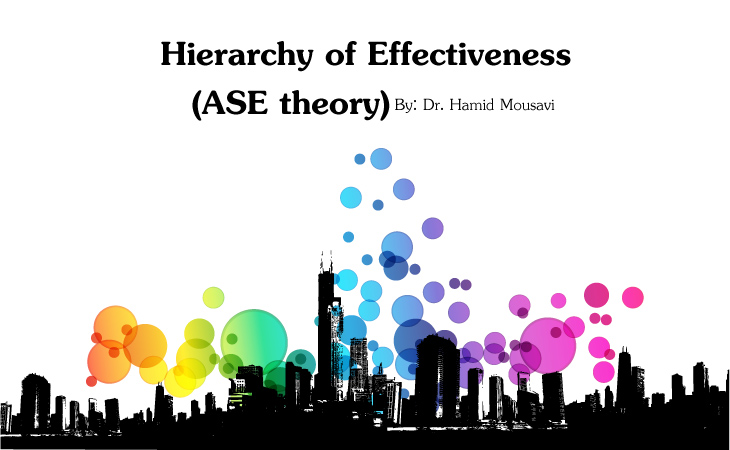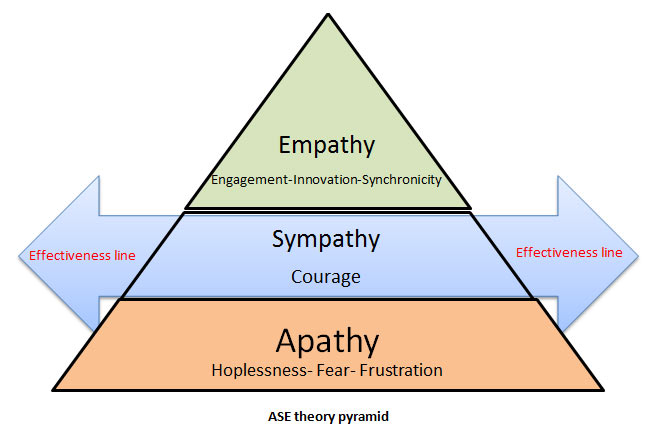
What is ASE?
ASE is a missing link in all the management studies, that is shortcut to a super effectiveness, which has unfortunately been avoided by thinkers in all humanities, even the founders o effectiveness.
The ASE approach consists of three components: Apathy, Sympathy, and Empathy, which we will discuss in detail.
As can be seen, the above pyramid contains three very important components and titles, which have been referred to as an island to the third level in the evolutionary leadership, books and management articles.
This triangle is a practical solution that can respond to any individual, collective and trans-collective pain, ie global. And without going beyond the first level objectively and tangibly, there is no way to get to the next stage and there are no exceptions. It should be noted that the pyramid is initially divided into three important and general parts. And each of them has its own divisions.
Apathy
- Hopelessness
- Fear
- Frustration
Sympathy
- Courage
Empathy
- Engagement
- Innovation
- Synchronicity
According to the researcher, paying attention to one dimension and ignoring the other dimensions of the case will not only lead us to the desired result, but will also cause more confusion. Therefore, it is necessary to look at this issue systematically, in order to reach a proper conclusion.
ASE theory is based on self-understanding
The ASE theory, or hierarchy of effectiveness, is based on self-understanding and is the result of years of research and concern, which we will analyze as a summary and analysis of the theories presented in this chapter.
If we consider the achievement of goals as one of the effectiveness definitions and accept it, how can we answer that if there is no goal or motivation to create and pursue a goal in our hearts and souls, no scientific school will be able to answer the problem? When I prefer aimlessness to anything valuable in this world, none of the existing super-theories, from philosophy to today’s psychology, will benefit me.
When man’s perception of himself as a aimless existance and he does not know otherwise, his experience is limited to this verse:
“Our share of life is smelling like a dog in a garbage dump”
No matter how much you give him, not only have you not helped him, but you have persuaded him to stay longer than to walk, which will make it possible for him to open his chains.
What is the expectation of a human being who has a foot without pass, and whose share of thinking is only to grieve, and who regrets his time?
By what principle can man be moved while a history of negligence carries with it? A human being who prefers to stay is to stay. It is here, of course, that the late Albert Einstein must be quoted as saying, “A particular problem which has arisen under certain intellectual conditions cannot be solved by the same thoughts that create it.”

So the question of effectiveness, which inherently has empowerment potential, comes to us at this stage. Of course, it is one kind of effectiveness that not to tie the hands and feet of man and not to mention him as a condemned or victim of destiny, but to consider him as the creator of his destiny. Isn’t man the architect of his own destiny?
With this in mind, we sit down for a sweet discussion of the components of effectiveness. In the effectiveness hierarchy triangle, there are three components or attributes:
- Apathy
- Sympathy
- Empathy
In the initial classification, the hierarchy of effectiveness is divided into three parts: Apathy, Sympathy, and empathy. And each of these elements has its own definition, which in fact the factors that create it are considered a feature or element.
The main elements of a sense of Apathy Thus, the main factors of the feeling of Apathy are:
1- Hopelessness
2- Fear
3- Frustration
In other words, Apathy is a feeling of hopelessness combined with fear, a sense frustration and failure.
And the only factor of sympathy is the sense of courage and bravery, which is also rooted in compassion and altruism.
The basic elements of empathy are:
1- Engagement
2- Innovation
3- Synchronicity
Thus, the definition of empathy will be the simultaneous innovative commitment and obligation, which is also referred to as the sense of representation. Of course, it is necessary to explain that each of the seven levels also has two ingredients, which by explaining each of them, will show its weak, good and excellent effectiveness. In this way, it will not be possible to enter the second stage without passing from the first level, and not only will we not see effectiveness, but we will face low performance at three levels: individual, group and organizational. While in the third level, we will see the higher effectiveness. In other words, we will be a great part in individual, group and organizational dimensions.
The main elements of the feeling of despair and hopelessness are:
A. Shame (Feeling worthless).
B. Dispiritedness (Being fed up with life).
That is, despair is the feeling of being worthless and fed up with life. And if we want to give a precise definition of despair, it will be a fundamental inability to observe or work on the horizon of a positive and bright future. In other words, despair is a fundamental inability to understand a positive future. According to two counselors, life is energy and this energy can have two aspects that you can call love and fear, ups and downs or easy and hard. Everything we do, think or feel is the source of one of the two. The first level of effectiveness, which is also the weakest level of effectiveness, is the level of despair and hopelessness. According to Dr. Hawkins’ research, a person’s level of happiness at this level is 1-5% of the total 24 hours. (Ann Betz and Ursula Pottinga,2016, p. 4).
The main elements of the sense of fear:
A. Anxiety (The feeling of losing forever).
B. Craving (The desperate need for support).
The main form of fear arises from the two elements of anxiety and the intense need for something in human beings. In other words, fear is the feeling of losing one’s life and the intense need for support from others. And if we want to provide an understandable definition, fear will be: the belief that one should be protected against the loss, invasion, or failure of something. The second level of effectiveness is the level of fear, which according to research by Dr. David Hawkins, the level of human happiness at this level will be 9% -10% in 24 hours.
The main elements of a sense of frustration are as follows:
A. Anger and turmoil
B. Egotism and self –assertion
Frustration and inability of two traits or a state of anger and egotism arises in man, that is, the basis of frustration in a person is associated with two inner traits of anger and egotism. In other words,
In simpler terms, Frustration is a state of turmoil and self-assertion. Frustration is a sense of rebellion against the world outside and the people to the prevailing conditions. Therefore, before dealing with the fourth level of effectiveness, which is also called the) Middle line or Effectiveness line(, it is better to show the seven levels as follows so that the problem can be digested well and with higher efficiency. At the level of frustration, the happiness of people is 12% -22% of the total 24 hours given to them.
will be continued …










